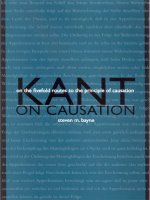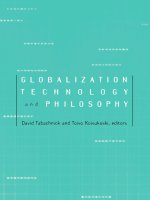state university of new york press higher education and international student mobility in the global knowledge economy apr 2008
Bạn đang xem bản rút gọn của tài liệu. Xem và tải ngay bản đầy đủ của tài liệu tại đây (3.12 MB, 356 trang )
Kemal Gürüz
Higher Education
and
International Student Mobility
in the
Global Knowledge Economy
HIGHER EDUCATION
AND INTERNATIONAL
STUDENT MOBILITY
IN THE GLOBAL
KNOWLEDGE ECONOMY
This page intentionally left blank.
HIGHER EDUCATION
AND INTERNATIONAL
STUDENT MOBILITY
IN THE GLOBAL
KNOWLEDGE ECONOMY
Kemal Gürüz
State University of New York Press
Published by
State University of New York Press, Albany
© 2008 State University of New York
All rights reserved
Printed in the United States of America
No part of this book may be used or reproduced in any manner whatsoever
without written permission. No part of this book may be stored in a retrieval system
or transmitted in any form or by any means including electronic, electrostatic,
magnetic tape, mechanical, photocopying, recording, or otherwise
without the prior permission in writing of the publisher.
For information, contact State University of New York Press, Albany, NY
www.sunypress.edu
Production by Marilyn P. Semerad
Marketing by Michael Campochiaro
Library of Congress Cataloging-in-Publication Data
Gürüz, Kemal.
Higher education and international student mobility in the global knowledge
economy / Kemal Guruz.
p. cm.
Includes bibliographical references and index.
ISBN 978-0-7914-7413-6 (hardcover : alk. paper)
1. Education, Higher. 2. Student mobility. 3. Foreign
study. 4. Knowledge management. I. Title.
LB2322.2.G87 2008
378—dc22
2007032222
10987654321
Contents
List of Illustrations ix
Acknowledgments xiii
List of Abbreviations xv
Chapter 1. The Global Knowledge Economy and
Higher Education
1
1.1. Introduction 1
1.2. Globalization and the Knowledge Economy 3
1.2.1. The Industrial Society 3
1.2.2. Transformation to the Knowledge Society
and the Global Knowledge Economy 5
1.3. The Global Higher Education Agenda 14
Chapter 2. Enrollment and Increasing Demand 21
2.1. Increasing Demand 21
2.2. Demographic Shift and Nontraditional Students 31
2.3. Increasing Demand and International
Student Mobility 34
Chapter 3. The Rise of Market Forces 35
3.1. Historical Background 35
3.2. Public Spending and Tuition Fees 37
3.3. Private Institutions 44
3.4. Changing Patterns of Governance 52
3.4.1. Historical Background 52
3.4.2. The State, the Academia, and the Society as
Actors in Governance 56
3.4.3. Transformation from the Regulatory to the
Evaluative State 58
v
3.4.4. Spread of Lay Governance, Strengthened
Institutional Leadership, and a Redefinition of
Autonomy 67
3.5. The Rise of Market Forces in Relation to
International Student Mobility 77
Chapter 4. New Providers of Higher Education 79
4.1. Introduction 79
4.2. Impact of Technology 80
4.3. Impact of Technology on Traditional
Institutions 83
4.3.1. Distributed Learning 83
4.3.2. Virtual Arms and Unbundling of Services in
Traditional Institutions 86
4.4. Types of New Providers 91
4.4.1. Consortia and Networks 91
4.4.2. For-Profit Higher Education 93
4.4.3. Virtual Universities 99
4.4.4. Corporate Universities 100
4.4.5. Certificate Programs 102
4.4.6. Museums, Libraries, Publishers, and Media
Enterprises 103
4.4.7. Academic Brokers 103
4.4.8. Franchises and Branch Campuses 105
4.5. The Global Higher Education Market 113
Chapter 5. Globalization and Internationalization of
Higher Education
117
5.1. Historical Antecedents 117
5.1.1. International Academic Mobility in the Greco-
Roman and the Muslim Worlds 117
5.1.2. International Academic Mobility in Medieval Times 120
5.1.3. International Academic Mobility: 1500–1800 123
5.1.4. The Birth of the Napoleonic University and the
German Research University 127
5.1.5. International Academic Mobility in the Nineteenth
and Early Twentieth Centuries 129
5.1.6. The Emergence of the Modern American University 132
5.2. Globalization and Internationalization of Higher
Education since 1950 135
vi Contents
5.3. Definition of Terms 138
5.3.1. Globalization and Internationalization 138
5.3.2. Rationales for Internationalization of
Higher Education 140
5.4. The European Response: The Bologna Process 144
5.4.1. Chronological Background 144
5.4.2. An Evaluation of the Bologna Process 146
5.5. GATS: A “Commercial/Anglo-Saxon Response” 149
5.6. Quality Assurance in Transnational
Higher Education: “Multinational
Organizational Responses” 154
5.7. The Global Higher Education Agenda
and International Student Mobility 158
Chapter 6. International Student Mobility 161
6.1. The Global Picture Today 161
6.2. Major Host Countries 170
6.2.1. United States of America 170
6.2.1.1. ENROLLMENT STATISTICS 170
6.2.1.2. AN EVALUATION OF INTERNATIONALIZA-
TION POLICIES OF THE UNITED STATES 186
6.2.2. The United Kingdom 191
6.2.3. Germany 195
6.2.4. France 198
6.2.5. Australia 201
6.2.6. Other Major and Emerging Host Countries 204
6.2.6.1. JAPAN 204
6.2.6.2. RUSSIA 207
6.2.6.3. CANADA 208
6.2.6.4. NEW ZEALAND 210
6.3. Major Countries of Origin of Foreign Students 213
6.3.1. China: A Major Source Country and an Emerging
Major Host Country 213
6.3.2. India 216
6.3.3. Other Major Countries of Origin 218
6.4. Regional Breakdown of International
Student Mobility 229
6.5. International Student Mobility and
International Migration 232
Concluding Remarks 237
Contents vii
Appendix A: Data on Enrollment and Expenditures in National
Systems and International Student Mobility 245
Appendix B: Definition of Terms Related to Evaluation and
Quality Assurance 257
Appendix C: The European Credit Transfer and Accumulation
System and the Diploma Supplement 259
Appendix D: Recognition of Qualifications in Europe 263
Appendix E: Education, Training, and Youth Programs of the
European Union 267
Appendix F: Definitions of Foreign Students 271
Appendix G: General Agreement on Trade in Services 275
Notes 281
Bibliography 295
Index 317
viii Contents
Illustrations
FIGURES
2.1. Global Enrollment in Higher Education 24
2.2. Top Twenty Countries in National Enrollment in
Higher Education 26
2.3. Gross Enrollment Ratio in Selected Country Groups 28
2.4. Gross Enrollment Ratio in Selected Countries 29
2.5. Projected Global Demand for Higher Education 30
3.1. Expenditure on Tertiary-Level Education Institutions
per Student 38
3.2. Share of Private Sources in Expenditure on Tertiary-Level
Education Institutions 39
3.3. Share of Households in Expenditure on Tertiary-Level
Education Institutions 40
3.4. Share of Private Institutions in National Systems 46
3.5. The Depiction of the Rise of Market Forces in the Triangle
of Coordination 56
4.1. Growth of Enrollment in Australian Offshore Programs 108
6.1. Growth of Global Foreign Student Enrollment 162
6.2. International Student Mobility: Number of Students
Hosted; Top Twenty-five Countries in 2004 163
6.3. Forecast of Global Demand for International Student
Places in MESDCs 164
6.4. International Student Mobility: Students Hosted as
Percentage of Total Enrollment; Top Twenty-five Countries
in 2004 165
6.5. International Student Mobility: Number of Students;
Top Twenty-five Countries of Origin in 2004 166
ix
6.6. International Student Mobility: Students Abroad as
Percentage of Home Enrollment; Top Twenty-five
Countries in 2004 167
6.7. Growth of Foreign Student Enrollment in the United States 171
6.8. Major Countries of Origin of Foreign Students in the
United States, 1994–2005 173
6.9. Indian Students in the United States 174
6.10. Chinese Students in the United States 174
6.11. Korean Students in the United States 175
6.12. Japanese Students in the United States 176
6.13. Taiwanese Students in the United States 176
6.14. Canadian Students in the United States 177
6.15. Turkish Students in the United States 177
6.16. Students from Hong Kong in the United States 178
6.17. Indonesian Students in the United States 179
6.18. Thai Students in the United States 179
6.19. Malaysian Students in the United States 180
6.20. Vietnamese Students in the United States 180
6.21. Russian Students in the United States 181
6.22. Nigerian Students in the United States 181
6.23. Mexican Students in the United States 182
6.24. Brazilian Students in the United States 183
6.25. Colombian Students in the United States 183
6.26. International Scholars in the United States 184
6.27. American Students Abroad 185
6.28. Growth of Foreign Student Enrollment in the United
Kingdom 191
6.29. Growth of Foreign Student Enrollment in Germany 196
6.30. German Students Abroad 198
6.31. Growth of Foreign Student Enrollment in France 199
6.32. French Students Abroad 201
6.33. Growth of Foreign Student Enrollment in Australia 202
6.34. Growth of Foreign Student Enrollment in Japan 205
6.35. Japanese Students Abroad 206
6.36. Foreign Student Enrollment in the Former USSR and Russia 207
6.37. Growth of Foreign Student Enrollment in Canada 209
x Illustrations
6.38. Growth of Foreign Student Enrollment in New Zealand 212
6.39. Chinese Students Abroad 214
6.40. Growth of Foreign Student Enrollment in China 216
6.41. Indian Students Abroad 217
6.42. Korean Students Abroad 219
6.43. Moroccan Students Abroad 220
6.44. Greek Students Abroad 220
6.45. Turkish Students Abroad 221
6.46. Malaysian Students Abroad 222
6.47. Indonesian Students Abroad 224
6.48. Students from Hong Kong Abroad 225
6.49. Singaporean Students Abroad 227
6.50. Mexican Students Abroad 227
TABLES
1.1. Demographic, National Income, and Educational Data for
Selected Countries 9
1.2. National Innovation Systems: R&D Indicators 10
1.3. National Innovation Systems: ICT Indicators 11
2.1. Breakdown of Global Enrollment by Region 25
4.1. Characteristics of the Largest Publicly Traded For-Profit
Companies in the United States 95
5.1. Foreign Students in France and Germany in the Late
Nineteenth and Early Twentieth Centuries 131
5.2. Export Earnings from Foreign Students 143
6.1. Top Ten Host Countries in Different Years 168
6.2. Top Ten Countries of Origin in Different Years 170
6.3. Major Countries of Origin of Foreign Students in Germany 197
6.4. Regional Distribution of International Student Mobility 230
6.5. Origin of Foreign Students by Geographical Regions 231
A.1. Enrollment Characteristics of National Higher Education
Systems 246
A.2. Expenditure per Student and Its Breakdown by Source 250
A.3. Tuition Fees and Total Annual Costs of Higher Education
in Selected Countries 252
A.4. International Student Mobility 254
Illustrations xi
This page intentionally left blank.
Acknowledgments
My interest in higher education governance as a scholarly pursuit in itself
started twenty-five years ago, when I was appointed dean of the Graduate
School at Middle East Technical University. Since then, I have served at
nearly all levels of the Turkish higher education system and represented my
country in a number of international organizations. The last position I held
was president of the Council of Higher Education, national board of gover-
nors at the top of the system, where I served for two terms from 1995 to
2003. I take this opportunity to express my heartfelt gratitude to Süleyman
Demirel, the ninth president of the Republic of Turkey, who appointed me
to that position, and put his unwavering support behind the council in its ef-
forts to internationalize the Turkish higher education system. A believer in
an interdependent, global world, in which nations coexist in harmony and
peace, advancing humanity in all fronts, President Demirel also acted as the
intellectual leader of the Turkish higher education system.
It was in my capacity as the president of the council that my association
with the State University of New York (SUNY) system started, when in the
summer of 2000 I met former chancellor John W. Ryan and Robert Gosende,
associate vice-chancellor for international programs, at an international meet-
ing on higher education. It was during this meeting that the current dual-
diploma program between Turkish universities and the SUNY system was
hatched; enrollment in the program currently stands well over one thousand
students, and is projected to reach two thousand.
When I stepped down from my position as the president of the council, I
was accepted to participate in the Fellows Program at the Weatherhead Center
(WCFIA) for International Affairs at Harvard University for the 2004–2005
academic year. On December 2, 2004, I was awarded the first “Chancellor
John W. Ryan Fellowship in International Education” by the State University
of New York. The first draft of this book was written during that academic
year, which I spent at WCFIA, while at the same time lecturing at various cam-
puses of the SUNY system on several aspects of international higher education.
This book was thus made possible with the generous support provided by the
central administration of the SUNY system and the WCFIA. My deep gratitude
goes to John W. Ryan, whose name I now proudly carry in my title as the first
xiii
recipient of the fellowship named after him; Thomas Egan, chairman of the
board of trustees of the SUNY system; Robert King and John Ryan, succeeding
chancellors, and John O’Connor, vice-chancellor and secretary general of the
SUNY system; Jorge Dominguez, the then director of WCFIA and the current
vice president of Harvard University for international education; Steve Bloom-
field, assistant director of WCFIA; and Kathleen Molony, director of the fel-
lows program at WCFIA.
It was during those lectures at the SUNY campuses where I had the chance
to interact with leaders in the field of international higher education—Bruce
Johnstone, Dan Levy, Henry Steck and Stephen Dunnett—and in the intellec-
tually invigorating atmosphere at WCFIA, that the contents of the present
book began to take shape. Philip Altbach kindly allowed me to audit his course
on higher education at Boston College. I not only benefited from Phillip’s im-
mense knowledge and experience in international higher education, but also
enjoyed his friendship. No less were the contributions that my friend John
Ryder made during the times we drove around upstate New York, speaking in
various languages, some of which we created. John also kindly edited the first
draft of the book.
I thank James Peltz, interim director of the SUNY Press, Lisa Chesnel,
my acquisitions editor there, and Marilyn Semerad, Director of Production,
without whose efforts this book would not have been possible.
My vocabulary fails me in thanking Robert and MaryBeth Gosende,
with whom I start thanking family members, for my wife Güniz and I have
come to consider them as brother and sister. Many a time, I wonder what I
have done to deserve friends like Bob and MB.
Last, but not least, I thank my beloved wife Güniz for so unselfishly
putting up with and supporting me, and our son Murat, who has made us
proud. As someone with his ancestral roots in today’s Greece, Bulgaria,
Cyprus, and Turkey, with a Turkish and American education, and currently a
knowledge worker traveling between San Jose, Mexico, and the Philippines,
Murat possibly epitomizes the title and the content of this book.
xiv Acknowledgments
Abbreviations
AAU American Association of Universities
ACE American Council on Education
AEI Australian Education International
AIEA Association of International Education Administrators
AUCC Association of Universities and Colleges of Canada
BCCIE British Columbia Center for International Education
BCCIHE Boston College Center for International Higher Education
BFUG Bologna Follow-Up Group
CBIE Canadian Bureau of International Education
CEPES European Centre for Higher Education (UNESCO,
Bucharest)
CHEA Council for Higher Education Accreditation
CIC Citizenship and Immigration Canada
CNE National Committee for Evaluation (Comite National
d’ Evaluation)
CRE Conference of Rectors, Presidents and Vice-Chancellors of
European Universities (Conference des Recteurs Europeens)
DAAD Deutscher Akademischer Austausch Dienst
DETC Distance Education and Training Council
DS Diploma Supplement
EC European Commission
ECTS European Credit Transfer and Accumulation System
EEA European Economic Area
xv
EHEA European Higher Education Area
ENIC European Network of Information Centers
ENQA European Network of Quality Assurance
ERA European Research Area
ESIB International Union of Students in Europe
EU European Union
EUA European Universities Association
FE Further education (in the United Kingdom)
GATS General Agreement on Trade in Services
GDP Gross domestic product
GNP Gross national product
GER Gross enrollment ratio
HEFCE Higher Education Funding Council for England
HEFW Higher Education Funding Council for Wales
HESA Higher Education Statistics Agency
IAU International Association of Universities
ICHEFAP International Comparative Higher Education and
Accessibility Project
ICT Information and communication technologies
IDP International Development Program (IDP Education
Australia)
IIE Institute of International Education
ISCED International Standard Classification of Education
NAFSA National Association of Foreign Student Advisors
NARIC National Academic Recognition Information Centers
NASULGC National Association of State Universities and Land-
Grant Colleges
NCAA National Council for Academic Awards
NCES National Center for Education Statistics
NIAD-UE National Institute for Academic Degrees and University
Evaluation
xvi Abbreviations
NIS National innovation system
NPEC National Postsecondary Education Cooperative
NZQA New Zealand Quality Agency
OBHE Observatory on Borderless Higher Education
OBHE-A OBHE Articles
OBHE-BN OBHE Breaking News
OBHE-BNA OBHE Breaking News Article
OBHE-BfN OBHE Briefing Note
OBHE-KI OBHE Key Issue
OECD Organization for Economic Cooperation and Development
PCFC Polytechnics and Colleges Funding Council
PTE Private training establishment
QAA Quality Assurance Agency (United Kingdom)
SHEFC Scottish Higher Education Funding Council
SIU Senter for Internasjonalisering av Hoyere Utdanning
(Norway)
STS Sections de Techniciens Superieures (France)
TAFE Technical and further education (in Australia)
UFC Universities Funding Council
UGC University Grants Committee
UKCOSA The Council for International Education (United Kingdom)
UNESCO United Nations Educational Scientific and Cultural
Organization
USDE United States Department of Education
WTO World Trade Organization
Abbreviations xvii
This page intentionally left blank.
Chapter 1
The Global Knowledge Economy
and Higher Education
1.1. INTRODUCTION
Global refers to worldwide in scope and substance and de-emphasizes the
concept of nation, but without negating it. Globalization, in general, is the
flow of technology, knowledge, people, values, ideas, capital, goods, and ser-
vices across national borders, and affects each country in a different way due
to the nation’s individual history, traditions, culture, and priorities (Knight
2004). Economists define globalization more narrowly as the integration of
commodity, capital, and labor markets.
In any case, globalization involves the coming together and interaction of
human beings. Thus, the process of globalization began with the genesis of
human beings. It has always been driven by the human desire for economic and
political gains, a zeal for spreading faith, ideology, and culture, and a quest for
new knowledge. It has been made possible by advances in transportation and
communication technologies. Globalization is clearly a continuous process that
is dependent on and intertwined with technological progress.
Until about two centuries ago, it was possible to identify different civi-
lizations as distinct from one another, simply because transportation and
communication technologies were not as developed and widely available as
they are today. This meant that different communities could not interact suf-
ficiently to influence each other in a manner that would lead to new socio-
economic and cultural syntheses. Since then, and especially in the previous
century, however, a single global civilization has emerged that, like a marble
or an amalgam, consists of the “higher outputs” of different cultures, polit-
ical, scientific, technological, socioeconomical, artistic, and literary that are
1
now shared by the masses worldwide. McNeill and McNeill (2003, 325),
describe this process as follows:
Civilizations engulfed originally independent human communities,
creating new, more powerful bodies politic, economic and cultural;
and being more powerful, they persistently spread to geographically
favorable new ground. Moreover, their spread meant that across
the past millennium, as communications intensified, what began as
separate civilizations followed a familiar path by blending into an
ever more powerful, global, cosmopolitan web that now prevails
among us—a huge web of cooperation and competition sustained
by flows of information and energy.
At the very core of this single global civilization is rational, critical human
thought and reasoning, which originated in the Hellenic world in the first half
of the sixth century BC.
1
From there, it followed a tortuous path over a vast
area extending from China to Spain before eventually reaching the West to
form the core of today’s global civilization. Scholars, polymaths, philosophers,
and students wandering from one place to another throughout centuries played
a key role in spreading ideas, knowledge, know-how, and civilization.
This book is about how the international mobility of students, scholars,
programs, and institutions of higher education evolved over time, and the
ways in which it is occurring in today’s global knowledge economy.
Students and scholars leaving their homes on a quest for education and
knowledge is not a new phenomenon; neither are the transplantation of ed-
ucational institutions, and the transfer of the epistemic knowledge base of
curricula and textbooks from one culture to another. In medieval Europe,
for example, there were times when foreigners accounted for about 10 per-
cent of the student enrollment across the continent. This figure is much
higher than the share of foreign students in higher education enrollment
worldwide today, which is about 2 percent. However, the number of foreign
students today is a staggering 2.5 million worldwide, compared to a few
hundred in medieval Europe. At that time, students traveled to other places
simply because there were no institutions where they lived. Today, there are
over seventeen thousand institutions of higher education in 184 countries
and territories in the world, and opportunities for access have been vastly
improved for masses since then. This is what makes the relatively smaller
number of foreign students in higher education today much more signifi-
cant. The question then is, what has caused this expansion? In other words,
what are the rationales, on the part of students and their families, the gov-
ernments of their countries of origin, and the institutions and countries host-
ing them, that are driving this expansion? Furthermore, student mobility,
although the biggest part, is just one component of the international higher
education scene in today’s world. More than one rationale is at work, and a
2 Higher Education and International Student Mobility . . .
multitude of modalities and opportunities exist, which are expanding aca-
demic mobility today, and they are all interdependent.
This book is an attempt to survey the literature on these complex phenom-
ena. Academic mobility, in its various forms, is and has been an important
aspect of the process of globalization throughout history. Rapid technological
developments have made and are making it much easier and faster today.
However, this is only part of the picture, even when analyzed in a historical
perspective. Any attempt to study academic mobility without linking it to the
evolution of institutions, structures, systems, functions, governance, adminis-
tration, and financing of higher education throughout history would be incom-
plete. Developments in higher education worldwide that have taken place in
the second half of the twentieth century, particularly those that have been par-
alleling the onset of the global knowledge economy, are particularly pertinent
to the topic at hand.
1.2. GLOBALIZATION AND THE KNOWLEDGE ECONOMY
Throughout history, knowledge, as both technical expertise and any kind of
information, has been important to humankind for improving the quality of
life. What have changed over centuries, however, are the characteristics and
the quality of knowledge, the relative importance of science as its source, the
methods by which it is created, stored, accessed, transmitted, acquired, and
retrieved, its relative importance as a production factor, and the level of
education and training required in the workforce.
1.2.1. The Industrial Society
Until the late nineteenth century, technology was developed independently of
science; technological developments, in general, preceded scientific develop-
ments.
2
The Industrial Revolution that took place between 1760 and 1830
began with the invention and commercialization of the steam engine by James
Watt (1736–1819), long before the formulation of the laws of thermodynam-
ics that govern the relationships between heat and mechanical energy and the
limitation imposed by nature on the conversion of the former to the latter.
Based on the educational backgrounds of the technological leaders of the
Industrial Revolution, it can also be argued that the university as an institu-
tion made little, if any, contribution to the Industrial Revolution.
3
Mokyr
(2002, 37–41), on the other hand, argues that the Scientific Revolution and
the Enlightenment, both of which owed indirectly to universities and other
institutions of higher education, resulted in what he refers to as “Industrial
Enlightenment.” He cites the associations of technical and scientific knowl-
edge, whose number in England had reached 1,020 by the end of the nine-
teenth century with a total membership of about 200,000, as a major
contributor to the Industrial Enlightenment.
4
It should, however, be pointed
out that chairs and professorships in various branches of natural sciences had
The Global Knowledge Economy and Higher Education 3
been established in Oxford and Cambridge as early as the beginning of the
seventeenth century, and by the end of that century, Scottish universities—
St. Andrews (f. 1411), Glasgow (f. 1451), Aberdeen (f. 1495), and Edinburgh
(f. 1589)—together with the Dutch universities—Leiden (f. 1575), Groningen
(f. 1612), and Utrecht (f. 1636)—had emerged as the leading scientific and
intellectual centers in Europe. It is inconceivable that the scholarship of the
Scottish universities did not permeate the neighboring northern England, the
cradle of the Industrial Revolution. Furthermore, the dissenting academies,
where such great scientists as Joseph Priestley (1733–1804) and John Dalton
(1766–1844) gave public lectures, were concentrated in the new commercial
and industrial centers—Manchester, Liverpool, and Birmingham—where
rich merchants and industrialists sponsored and supported them. Many of
the mechanical institutes affiliated to the Royal Institution were also located
in this region.
5
The role that universities and other institutions of higher ed-
ucation played in the Industrial Revolution was obviously indirect; neverthe-
less, it should not be underestimated.
However, owing mainly to the German research universities (see section
5.1.4), an entirely different picture started to emerge in the nineteenth cen-
tury. Scientific breakthroughs achieved in laboratories led to new technolo-
gies, which, in turn, formed the bases of new industries. The chemical
industry and electrical technologies are generally considered the first science-
based industries.
6
The period from about the middle of the eighteenth century to the be-
ginning of the twentieth century marks the advent of the industrial society,
which is characterized by technologies and industries based on the results
of scientific research, replacement of inventions and inventors by innova-
tions and organized research and development (R&D) activity, and the
appearance of large-scale, smokestack factories mass-producing goods.
In the pre-industrial society, individual scientists and scholars worked in
isolation, even away from the universities where some of them were em-
ployed. With the advent of industrial society came the university research
laboratories, and public research institutes. Physikalisch-Technische Reichs-
anstalt (f. 1887), the Kaiser Wilhelm Gessellchaft (f. 1911, renamed Max
Planck Institutes in 1948), and the industrial R&D laboratories, such as
those of the German chemical giant Badische Aniline und Soda-Fabrik
(BASF; f. 1865), were the first ones in Germany.
7
Research laboratories of
General Electric and Bell Telephone, and Edison’s laboratory/shop in Menlo
Park were the pioneers in the United States.
To channel public funds more effectively and to organize R&D activi-
ties toward national goals, institutions were established as early as the first
quarter of the twentieth century. In this manner, national R&D systems
began to emerge, comprising universities, public research institutions, and
private sector research departments, each with distinct but partially overlap-
ping and complementary functions.
8
4 Higher Education and International Student Mobility . . .
Technological progress financed by credit and sustained by innovations
resulting from organized R&D activity was identified by Joseph Schumpeter
(1883–1950) as the main driver of capitalist growth as early as 1934
(Mokyr 1990, 8). Such progress and growth effectively led to new scientific
discoveries, which, in turn, formed the bases for new technologies, and
opened up entirely new vistas for the humankind.
9
Since then, the precursor–follower type of linear relationship between
science and technology has been transformed into a much more intertwined,
complex, and fuzzier relationship, where a science-based technology opens
up a new scientific field that, in turn, forms the bases for a new set of tech-
nologies, and so on. The last quarter of the twentieth century especially was
a period in which distinctions between basic research, applied research, and
technological research and development and industrial applications, and
even marketing (for example, e-commerce) and financing (for example, ven-
ture capital) were increasingly blurred.
1.2.2. Transformation to the Knowledge Society
and the Global Knowledge Economy
Out of this complex historical process in which many factors interacted over
a period spanning more than one hundred years, but especially in the last
quarter of the previous century, technologies emerged, which have started to
change our lives profoundly, chief among which are the information and
communication technologies.
Information and communication technologies involve innovations in mi-
croelectronics, computing (hardware and software), and telecommunications,
in an integrated and interactive manner. Thus, these technologies, collectively
abbreviated as ICT, enable the processing, storage, and transmission of and
access to enormous amounts of data through communication networks. The
Internet has grown exponentially, from 16 million users in 1995 to more than
1 billion users in 2004 (see table 1.3).
The ICT revolution is transforming the “industrial society” into the
“knowledge society.” A number of other factors, some of which are in fact by-
products of the complex interactive process I have outlined, have also con-
tributed to this transformation. However, it is not possible to assign a specific
date to this transformation. In a recent article, Bill Gates (2006) points out
that it was in the last twenty years that the word knowledge became an adjec-
tive. The widespread availability of the Internet through personal computers
equipped with browsers and the establishment of the World Wide Web in the
early 1990s have indeed revolutionized the way we live, and thus, in the eyes
of many, epitomize the transition to the knowledge society and the global
knowledge economy.
10
At the beginning of the nineteenth century, “the global economic world”
comprised only North America and Western Europe that is, the so-called
The Global Knowledge Economy and Higher Education 5
Atlantic economy. Japan started to join in the last quarter of the nineteenth
century, after she was forced to open her ports by Commodore Perry in 1854
and the Meiji Restoration that followed (1868–1912). The sociopolitical
changes coupled with and driven by the ICT revolution, which made it possi-
ble for people to become aware of and informed about events and develop-
ments in other parts of the world, radically transformed the world economy
and led to dramatic policy changes around the world. In 1978, Deng Xiao-
ping began to pave China’s way toward capitalism. The Berlin Wall fell on
November 9, 1989, which symbolized the implosion of the Soviet system. In
1991, with her model no longer intact, India abandoned the autarkic socialist
system, and starting with her telecom industry, opened her economy to for-
eign investment and competition. These were paralleled by the consolidation
of civilian rule in Latin America, and a much more improved sociopolitical
landscape in Africa. In summary, the proportion of the world’s countries prac-
ticing some form of democratic governance rose from 40 percent in 1988 to
61 percent in 1998 (World Bank 2002, 19). The global world now comprises
more than 6 billion people, nearly all of the global population.
11
Privatization rather than central planning, and export-competitiveness
rather than import-substitution, rapidly began to unify world markets. This
process, referred to as “economic globalization,” is intertwined with techno-
logical transformations. New tools of information and communication tech-
nologies make the world’s financial and scientific resources more accessible
and unify the markets into a single marketplace, where intense competition
further drives scientific and technological progress (UNDP 2001, 30–31).
The convergent and mutually reinforcing impacts of globalization and
the ICT revolution have radically changed not only the methods and struc-
tures of production, but also the relative importance of the factors of pro-
duction. The transformation from an industrial society to a knowledge
society and the global knowledge economy is characterized by the increased
importance of knowledge, both know-how and information, and a well-
trained workforce that not only can apply know-how, but is also capable of
analysis and decision making based on information. Just as the steam engine
and electricity harnessed inanimate power to make possible the Industrial
Revolution, digital breakthroughs are channeling brainpower to form the
basis of the knowledge economy (UNDP 2001, 4).
In summary, knowledge and people with knowledge are the key factors of
development, the main drivers of growth, and the major determinants of com-
petitiveness in the global knowledge economy. In his seminal work on com-
petitive advantage, Porter (1990) had already pointed out a decade and a half
ago that a nation could no longer rely on abundant natural resources and
cheap labor, and that comparative advantage would increasingly be based on
combinations of technical innovations and creative use of knowledge.
These complex interactions are now driving the science- and technol-
ogy-based global knowledge economy, where R&D and production are hor-
6 Higher Education and International Student Mobility . . .









